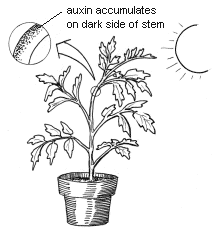We’ve all witnessed our windowsill plants leaning
toward the light. And some of us have experienced the frustration of a perennial bed where
all the flowers are facing the "wrong" way! In both these cases, the plants are
reacting to the location and intensity of the light source.The phenomenon of plants bending toward light is called phototropism (photo=light, tropos=turn).
For centuries, scientists struggled to explain how seemingly motionless plants were able
to turn and bend toward a light source. Eventually, scientists found that the
concentration and location of a certain chemical seemed to be associated with this
phenomenon. This chemical was named auxin (Gr. auxein
= to increase), and through various ingenious experiments it was determined that auxin is
a growth-promoting substance.
Plants respond to light by transporting auxin from one
part of the plant to another. When light shines on the side of a stem, auxin accumulates
on the dark side of the stem. The growth-promoting auxin causes these cells to elongate
more rapidly than the cells on the sunny side. As a result of this rapid growth, the stem
curves toward the light. As you might expect, the largest concentrations of auxin are in a
plant’s young, actively growing tissues—thus young growth is the quickest to
respond to changes in light.
Phototropism

The term auxin was initially used to describe what
were thought to be a group of chemicals responsible for promoting growth in response to
stimuli. It is now known that one chemical is responsible for many of these responses;
this chemical is called indole-3-acetic acid, or IAA. However, the term auxin is still
frequently used to refer to this chemical.
|
|
|
|
|